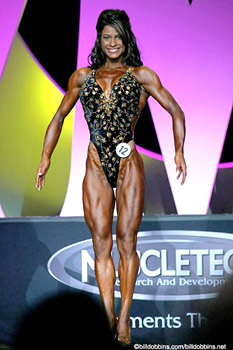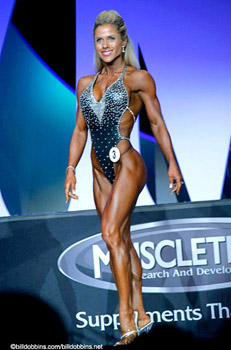THE OLYMPIA WEEKEND 2005
Orleans Hotel/Convention Center, Las Vegas
October 14-15
back
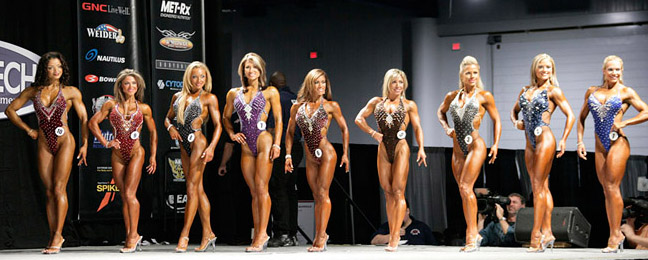
Figure Prejudging
INTRODUCTION
The NPC and then the IFBB began sanctioning
fitness some years ago in response to Wally Boyco's Ms. Fitness contests
and Lou Zwick's Fitness America. But
as it became apparent that the gymnastics-focused fitness routines were
too difficult (and in some cases dangerous) for many of the competitors,
both federations adopted figure competition in 2003 – an event
originally supposed to be fitness-without-the-routines but has turned
into something very different.
Fitness at the amateur
level is in decline, as least as far as the NPC is concerned. You frequently see competitions in which
there are 70 or more figure competitors, divided into 6 height categories,
and as few as two or three women entered in fitness. A big step in correcting this discrepancy
would be to simply change the requirements for fitness routines. The
Ms. Fitness contests were primarily designed to be televisions show and
having a stage full of gymnasts helped fill up the hour necessary to
package a TV show. But what has happened is that the gymnasts
have come to dominate NPC and IFBB fitness contests. If you aren't a lifetime, experienced
gymnast the deck is stacked against you. But
there are a lot of women who have "fitness physiques" who are competing
in figure in order to avoid having to do routines for which they don't
have the background and training – and finding that the genetic
requirements of figure are ruthless.
The NPC and IFBB need
to change the fitness routines by, at the very least, forbidding "tumbling"
– "such as somersaults, rolls, and handsprings, performed without
the use of specialized apparatus." (The Free Dictionary). If
you watch tumbling runs done in gymnastics competition (on padded mats,
not on a bare stage or a thin rug) you get the idea. If
this isn't done, the demise of fitness in the NPC – and eventually
in the IFBB – is just a matter of time.
Figure,
on the other hand, has it's own problems. Figure
is not fitness-without-the-routines. It has come to favor a totally different body type than the
compact physiques you see in bodybuilding and fitness. The bodies favored by figure judges tend
to be long-waisted, long-legged in proportion. To illustrate the difference, just stand Davana Medina next
to Monica Brant.
|
||
Davana Medina has the natural
"long proportion" physique that wins pro figure. Monica Brant has a more compact body and lost some shape when she tried to slim down too far. |
As
a rule, the top figure women tend to be extremely attractive. They often have more muscle than the federations would prefer
but because of their long proportions this muscularity rarely looks "bulky." This
is why I call figure competitors the "supermodels of the fitness industry." In the early 1980s, there was a movement
to create "soft bodybuilding" events, featuring women with bodybuilding
physiques who were not too big to appeal to people outside of the bodybuilding
world. Figure competitors
are obviously bodybuilders of a sort and so they seem to be what advocates
of soft bodybuilding had in mind.
The
problem with figure competition is that it isn't very interesting. Women in fitness do quarter turns, wearing
two different types of suits (for reasons never explained) and then do
their routines. The figure
women just do the quarter turns. As
attractive as the women are, audiences often find watching endless quarter
turns on stage to be tedious – especially in amateur events where
6 different height classes are involved.
But
no matter the type of routines allowed or whether you are talking about
fitness or figure, the bottom line is that fans like the way these women
look but tend to be reluctant to pay to see them – reluctant to
buy tickets and reluctant to buy physique magazines that feature them. Bodybuilders, whether male or female, often attract long-term,
highly devoted fans. With
a few notable exceptions (Monica Brant, Timea Majorova for example),
the fitness and figure women don't inspire the same kind of devotion.
But
for some reason (perhaps because people are often too willing to believe
what they read) this lack of a PAYING audience for fitness and figure
seems to have escaped the understanding of the federations, the magazines
and even many of the women themselves. At
the amateur level, ticket buyers are often friends and family of the
competitors, so having so many women competing means that an NPC national
event will make money from ticket sales (and from charging the competitors
themselves to enter the event). But
the same is not true of pro shows.
Ideally,
if you combine female bodybuilding, fitness and figure in the same event
there is a sufficient variety of different physiques on stage to help
sell tickets (assuming anybody has gone to the trouble to promote the
event and to publicize the individual "stars" involved). But
the organizers of the Olympia Weekend 2005 didn't see things this way. They
allowed all three categories of women to compete together at the prejudging
held on Friday afternoon at the Expo. But
then scheduled the fitness and figure finals for Friday night at the
Orleans Arena, along with a men's "Wild Card" event that allowed bodybuilders
not qualified for the Mr. Olympia to win a single special qualifying
slot.
As
described below, the results of this decision were disastrous.
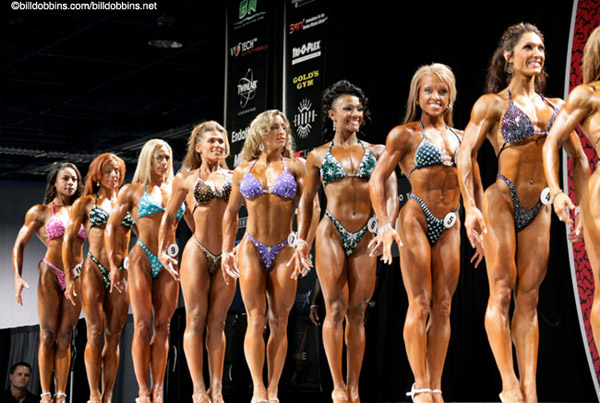
Fitness Prejudging
PREJUDGING
Fitness
Seeing
the competitors on stage in prejudging was an exercise in deja vu, or
"round up the usual suspects." Adela
Garcia won the Olympia Fitness in 2004 and was certainly a favorite here. I like the way Adela has filled out her
physique over the years, resulting in a much more pleasing shape. Jen Hendershott was probably the best
gymnast on in the contest but strong, compact physiques like hers often
have "symmetry" problems (the overall shape of the body, including
a V-shape torso and small waist).
Kim
Klein won the recent IFBB New York Pro Fitness Contest and so came into
the competition with some momentum. The
same was true of Tracey Greenwood, who won the Europa 2005 in Dallas
last August.
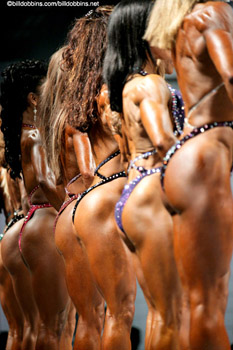 |
Women's Physique has a great future behind it. |
There
were no routines in prejudging, just quarter turns. The scoresheets show us that Adela was in the lead, Kim second,
Jen third and Tracey 4th.
Figure
If
you want a clear idea of what figure is all about – and why women
with compact fitness or bodybuilding physiques need not apply (at least
on the pro level) as described above, take a look at the Ms. Olympia
Figure line-up.
Four
of the top five have that long-proportioned "model" physique described
above: Davana Medina, Jenny Lynn, Amber Littlejohn and Mary Elizabeth
Lado. The only exception to this was Monica
Brant. Monica finished second
the last two years in a row. This year she was third. This gradual decline in placings is not inevitable, but it
is probable. Monica looks
fantastic, but has that "compact" physique which would allow her to win
a lightweight bodybuilding title (if she just gained a few pounds of
muscle and if the IFBB hadn't eliminated weight divisions for women bodybuilders).
She was lean but muscular two years ago, "softer" last year and in 2005
dieting down to the point of being somewhat "skinny." But you can't
fool mother nature.
But
overall you'd think the figure women would be considered highly promotable
by the industry. I don't really consider figure to be a true "sport"
as is bodybuilding (all sports are about going "to the limit" in terms
of physical performance, and that's not figure). But it's obvious looking at a pro figure
contest that the women involved are hard-training athletes and extremely
attractive as well. Given
that sponsors and magazines have a reluctance to involve themselves with
serious female bodybuilders, why on earth aren't all of them using the
services of these fabulous looking figure competitors? Why
does Muscle & Fitness (owned by AMI/Weider, a major owner of the
Olympia) put these women on the cover instead of NFL cheerleaders? Why are so few of them ever features
in Flex (which seems totally uninterested in IFBB or NPC women at all)?
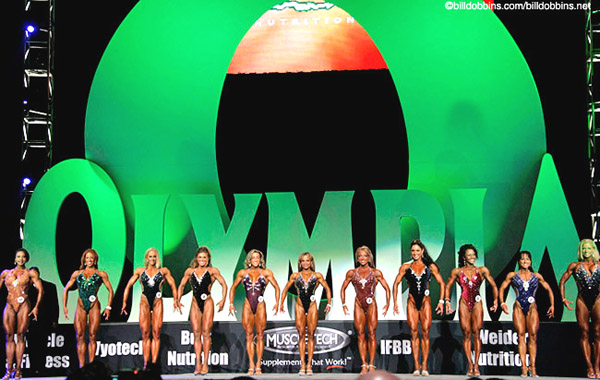
Fitness Finals - One Piece Suits Only To Leave Time for The "Wild Card."
THE
FINALS
The
turnout for the finals at the Orleans Arena was dismal. Most years that the finals of female
bodybuilding, fitness and figure held at the Mandalay Bay the ticket
sales were quite respectable. But
given the size of the Arena, there seemed to be almost nobody in the
house. So much for the idea of taking the Ms.
Olympia out of the mix and adding a men's "Wild Card" contest. It stands to reason that fans of men's
bodybuilding would prefer seeing the Mr. Olympia rather than buying tickets
to an also-ran event being held in conjunction with a woman's competition
and that fans of female bodybuilding would not be likely to buy tickets
to see just fitness and figure.
Bad
idea. Worse result.
The fitness competitors did their routines and they were reasonably entertaining. There aren't many photos of these routines because they were done on the basic stage - so low that photographers found it almost impossible to get any pictures that didn't have the heads of the judges in the way.
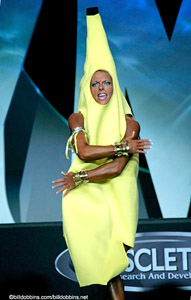 |
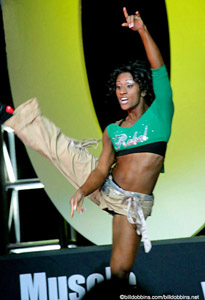 |
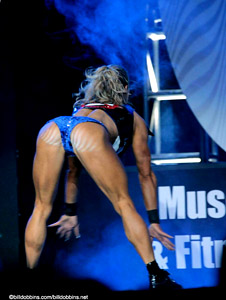 |
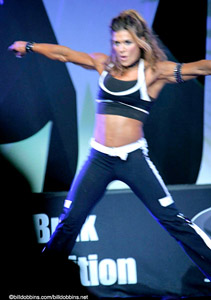 |
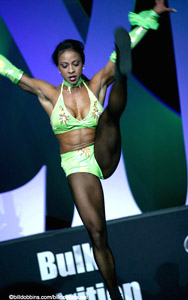 |
Many
of the women complained later at the amount of time they had to stand
around backstage while the Wild Card contest went on and on and on. When the fitness and figure women finally
did get to stand onstage they didn't even get to be compared doing quarter
turns. They only appeared wearing
one piece suits, not bikinis as well. Many
had friends and family in the audience who has gone to a lot of trouble
and spent a lot of money to attend the event. But
although the organizers advertised this as a women's night, it seems
as if they had little confidence that anybody actually wanted to see
the women. So there was no female bodybuilding and
much less fitness and figure than there should have been. Instead they added a "made up" event
for men of no significance except to those athletes actually competing.
The
fitness results once again demonstrated that fitness is too often nothing
more than a gymnastics contest. Jen
Hendershott, who was third in physique, placed first based on a really
well-done (and gymnastically-based) routine. Kim
Klein was third in physique, second in the routine and finished second. Adela
Garcia was first in physique, third in the routine round and finished
third.
You
have to wonder, why bother to have the physique round at all if the routines
are going to determine the outcome of the contest to such a great extent? And why are the IFBB and NPC, which are
physique federations, sanctioning gymnastics contests?
There were few surprises
when it came to figure. Davana
Medina won, as she has twice before. Jenny
Lynn was second, as might have been expected. One twist was that Amber Littlejohn finished
4th, one palce in front of Mary Elizabeth Lado, who had beaten
Amber at the Los Angeles Pro.
Monica Brant was third,
mostly I think because the judges don't want to place somebody with a
compact rather than long proportioned physique at the top – but
Monica looks so good they don't want to drop her too low. Second
last year, third in 2005 – this is likely to be a trend that will
continue in the future.
Meanwhile Monica is
likely to continue to be one of the most popular and successful women
in figure. If you want proof, just look at the line
of fans waiting to buy photos from her at an Expo.
FINAL COMMENTS
As things stand, if
you want to see exciting, well done women's events – fitness, figure
or female bodybuilding – you should attend the Arnold Weekend rather
than the Olympia. Jim Lorimer
and Arnold Schwarzenegger have promoting these contests down to a sign. The women are treated with respect they
are due and the women's finals are extremely well attended.
The current organizers
of the Olympia have a lot to learn. If
they want to hold prejudging at the Expo rather than looking for a way
to sell tickets, so be it. But
the Friday finals needs to include female bodybuilding as well as fitness
and figure, they need to do away with the seating arrangements (having
VIPs up front, then the judges way back and the press way, way back!),
and they need to PROMOTE the event all year long – which they can
do as the new owners of the Weider magazines.
They also need to open
the backstage to the press, at least during the women's events. Fitness, figure and women's bodybuilding
needs all the attention it can get and photos showing the women getting
ready in the dressing rooms and pumping up backstage all help to create
additional fan interest.
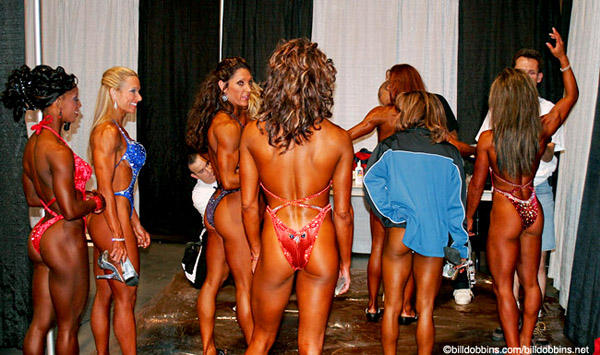
A rare backstage shot. For the most part, the backstage area at the Olympia
was closed to all but Weider photographers. But where will AMI/Weider
run those photos?
Don't hold your breath.
When Vince McMahon of
the WWE tried to move into bodybuilding years ago he made the mistake
of trying to reinvent the wheel. In
effect, he did EVERYTHING wrong because he was inexperienced in this
industry but still wanted to do things his own way.
The current Olympia
organizers keep trying to make physique competition more "exciting" and
appealing to the "general public." What
they should be doing is finding ways to create a weekend that uses all
the successful approaches from the past, add a huge amount of promotion
and publicity (neither the IFBB nor the NPC have full-time public relations
and AMI/Weider doesn't seem to have filled this gap) and THEN see if
there are some additions that can be made to make the Olympia even more
attractive to ticket buyers.
But it is NOT a valid
strategy to alienate the audience you already have in search of an audience
that you can't be certain even exists.
However, on the plus side nobody was talking about the "lose 20% muscle rule." Perhaps the IFBB is catching on to the fact that the physique audience likes muscle and EVERYBODY likes muscles on women as long as the women are attractive enough.
